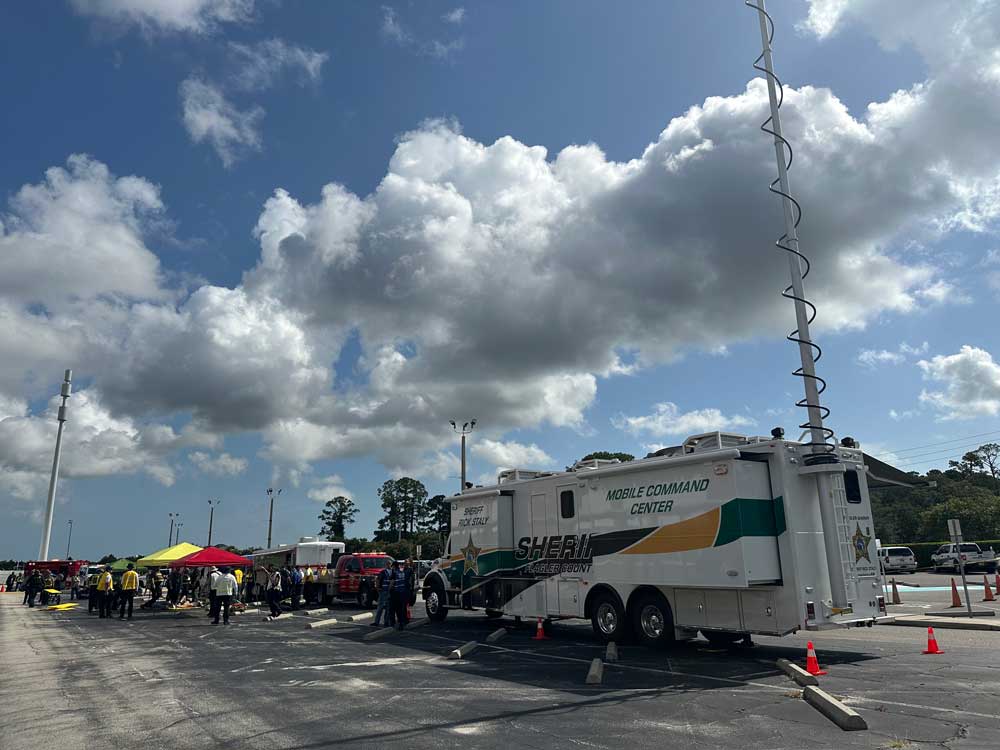
“This is an exercise.” That was the beginning and end of every communication on July 24 during a full-scale active assailant exercise held at Flagler-Palm Coast High School to ensure that anyone within earshot or sight of the message would be clear it was about a training exercise. And, while a realistic training exercise, no one was injured or killed.
“It is very important to be clear that we are exercising our response plans,” said Flagler County Emergency Management Manager Ryan Simpson, who took the lead in creating the exercise with the Exercise Planning Team that included representatives from participating agencies. “A good exercise is one looks, sounds, and feels very much like a real situation.”
Participants of the three-hour exercise included teams of people from the following agencies: AdventHealth Palm Coast hospitals; Bunnell Police Department; Flagler County Emergency Management; Flagler Beach Fire Department; Flagler Beach Police Department; Flagler County Fire Rescue; Flagler Schools; Flagler County Sheriff’s Office; Palm Coast Fire Department; and, Flagler Volunteer Services. One difference from many first responder type exercises was the necessary inclusion of 20 participants from AdventHealth, 40 participants from Flagler Schools, and additional volunteers coordinated by Flagler Volunteer Services.
In short, the training scenario was that of an armed assailant with school access firing indiscriminately in a crowded area of FPC and catching students, staff, and visitors off guard. Law enforcement, fire, and emergency medical services unified response follows. The situation necessitated reunification of family members following a mass casualty incident with fatalities.
“Ensuring the safety of our students is a top priority. Practicing our reunification process is a critical component of our emergency preparedness. In the event of an emergency, having a well-rehearsed reunification plan helps ensure that students are safely and efficiently reunited with their families,” said Flagler Schools Superintendent Lashakia Moore. “This practice not only enhances our response capabilities, but also provides peace of mind to parents in knowing that we are prepared to handle any situation that may arise on campus.”
Mission areas, core capabilities, and objectives were established and evaluated. A “hot wash,” or exercise debrief was held at the end of the training.
“It’s great to have an opportunity to practice and test our Active Assailant response and our 9-1-1 Emergency Response Teams under realistic circumstances,” said Sheriff Rick Staly. “We pray we will never need to use this training and equipment in a real active assailant situation, but the community should know we are trained, equipped, and ready should the need ever arise.”
Flagler County Fire Rescue Chief Mike Tucker spoke of the importance of the hotwash.
“The debrief is an important component of the training,” he said. “While everything went very well, it gives us an opportunity to see what the gaps are – or potential gaps – so that we can operate optimally during an actual deployment.”
All proved ready to work as a team.
“I am proud that our community partners can come together to develop and practice scenarios like today’s exercise,” said Emergency Management Director Jonathan Lord. “It is critically important that we are all ready to work as a team to support our community regardless of the type of emergency or disaster.”





























Joe D says
It’s DEFINITELY better they conduct REALISTIC, REGULAR practice drills ( and warn the public ahead of time). When you don’t practice, you get “rusty,” and things get overlooked. You NEVER can anticipate when this will happen, so practice DOES make perfect!
As a Clinical Nurse Specialist, I remember at my university teaching hospital, we had INTERNAL disaster drills (an emergency within the hospital: fire/electrical failure/ explosion) / small EXTERNAL disaster drills (outside accidents/fires/ chemical or biological exposures of less than 50 victims), the large EXTERNAL disasters ( same as small but with 50-200 victims). The large disasters had outside TRIAGE/STAGING areas in tents, BEFORE anyone went inside ( to separate/treat minor injuries, the more serious injuries went inside to a holding area (cafeteria/large auditorium/ large conference rooms)…only the most serious TRAUMA victims were actually sent to the ED.
It was a bit SCARY, because we knew at any time, we could be dealing with the REAL THING.